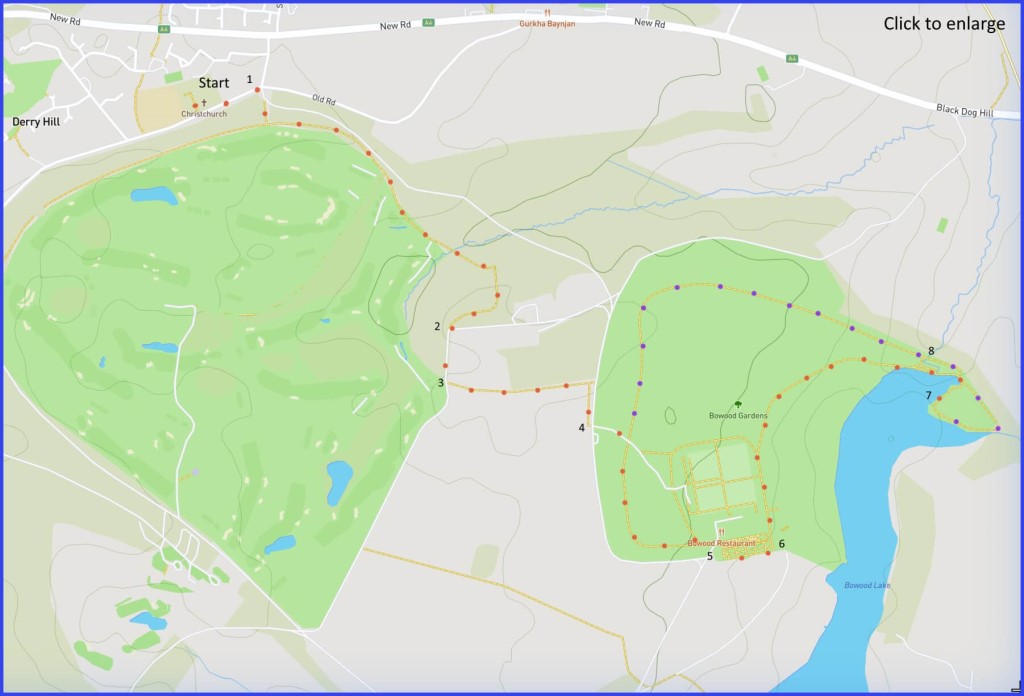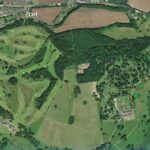A 3-mile easy Wiltshire walk around Bowood, along a wooded path starting in the village. Followed by a walk around the Bowood estate (there is an entrance charge). Parking is possible in a layby opposite Derry HIll church. Click here for an aerial view. Click here for printable PDF download.
(Routes suggested from each map point + metres to next point)
From Start, walk away from church towards road bend. Through gates on right towards House 30m
1: Pick up footpath entrance ahead ignoring arrow to ‘Bowood house’. Turn left at path junction and follow fenced path [A] around wooded edge [B] of golf course (signage keeps you off it). 900m
2: Enter paved road at sharp bend. Walk forward [D]. 160m
3: Leave lane and follow footpath towards house entrance and car park. 415m
4: Enter grounds (pay) and veer right towards House terrace. 425m
5: Walk across front of terrace [F]. 120m
6: Follow path round to classical garden pavilion [I]. 900m
7: Follow path to entrance (inspecting cascade/grotto). 1.4km
The pictures below are in the order things were seen on this walk. Clicking on any one will enlarge it (and the slideshow)
The walk
The starting point for this circular walk is Derry Hill: a village that emerged in the 19th century through amalgamating a number of small settlements on the edge of Bowood Park. But it is that park that is the real circle of the walks. Although – be warned – to complete it you have to pay an entrance fee. The village traditionally provided houses for estate workers, but it has grown beyond that. Its two most notable features for a passing visitor are the Victorian Gothic Christ Church and those monumental gates that are the official entrance to the Bowood estate. As a walker you may not use the gates. But you might take refreshment in the Lansdowne arms adjacent to them. The walk is then briefly through along a wooded path towards the House. Then an orchestrated stroll around the spacious grounds.
House and Park
What you find here now is a shadow of the original Bowood House. In fact, the present building was once called the “Little House”, because it was a mere attachment (by a long drawing room) to the grander “Big House”. The Big One lasted until the 1950s by which time it had become variously a school and an RAF camp. Finally, the 8th Marquess of Lansdowne had it knocked down. On the East side of the present Little House you will see a large rectangle of grass that defines the footprint of this once grander dwelling.
However, the existing building is worth a visit (besides, you have paid to get into the Park!). On the upper stories there are some interesting artefacts of both travelling and an earlier style of domestic living. Of particular interest is the role of Bowood as one gathering place for that generation of ‘gentleman scientists’ who flourished in the 18th century. One of the more interesting rooms is the one that served as Joseph Priestley’s‘ laboratory. He discovered oxygen there in 1774 (he also invented carbonated water and the rubber eraser – but perhaps not at Bowood). Priestly’s reputation for determining the composition of air seems firmly established, but it is also victim of those “not first to discover claims” often throw up by competing authorities. But why spoil a visit?
Yet much time here will probably be spent exploring the undulating landscape of the 1000-acre Park. It has all the elegance of design that is associated with its architect – Lancelot “Capability” Brown. Perhaps the terraces [F] around the house are at odds with Capability Brown’s principles, but they are attractively planted in a manner intended to remind the 3rd Marquess of Lansdowne of his trips to Italy. The wider grounds involve many of the romantic features admired by owners of large 18th and 19th century houses: a lake (contains a submerged village), the pleasure gardens, a mausoleum, a Greek temple, a hermit’s cave, water-worn rock cascades, and carefully located oak and beech trees. Perhaps just a little too picturesque? … but it still makes a very good walk.
Bowood aristocracy
A place like this is more than buildings and gardens. There will always be a story about those people who owned and lived there. In this case, tracing a lineage turns out to be a rather challenging cocktail of names – covering both titles (Shelburne, Lansdowne) and surnames (Bridgeman, Petty, Fitzmaurice, Petty-Fitzmaurice). The two significant family trees are displayed in the House (sadly, not adjacent) – in case you want to have a go at fully understanding the genealogy.
Perhaps the figures of most interest will be those at each end of the estate history. At the present end is Charles Maurice Petty-Fitzmaurice (b. 1941) who is the 9th Marquess of Lansdowne (one of the hereditary peers excluded from the House of Lords by the 1999 exclusion act). He had a military career, before unsuccessfully contesting a parliamentary seat for Coventry as a Conservative, But most of his political identity has been invested in various organisations functioning at county level.
At the distant end of the family tree is Sir William Petty (d. 1687). He managed to serve both Cromwell’s Commonwealth and the Stuart monarchy – as surveyor and economist. But he was also an eminent physician, natural scientist, inventor, merchant, and philosopher – even one of the founders of the Royal Society. So distinguished was William Petty that he was commemorated by the Lansdowne Monument: commissioned by Henry Petty-Fitzmaurice, 3rd Marquess of Lansdowne (a worthy politician, supporting the abolition of slavery and repeal of the Corn Laws). That notable county landmark could form the basis of another Wiltshire walk?



![[A]](https://wiltshirewalks.com/wp-content/uploads/2022/10/bowood_01-150x150.jpg)
![[B]](https://wiltshirewalks.com/wp-content/uploads/2022/10/bowood_02-150x150.jpg)
![[C]](https://wiltshirewalks.com/wp-content/uploads/2022/10/bowood_03-150x150.jpg)
![[D]](https://wiltshirewalks.com/wp-content/uploads/2022/10/bowood_04-150x150.jpg)
![[E]](https://wiltshirewalks.com/wp-content/uploads/2022/10/bowood_05-150x150.jpg)
![[F]](https://wiltshirewalks.com/wp-content/uploads/2022/10/bowood_06-150x150.jpg)
![[G]](https://wiltshirewalks.com/wp-content/uploads/2022/10/bowood_07-150x150.jpg)
![[H]](https://wiltshirewalks.com/wp-content/uploads/2022/10/bowood_08-150x150.jpg)
![[I]](https://wiltshirewalks.com/wp-content/uploads/2022/10/bowood_09-150x150.jpg)